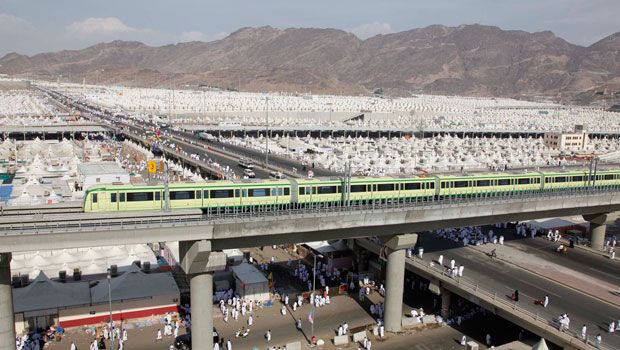Al Mashaaer Metro Line Project – Makkah (Mecca)

Exciting news is happening that will forever change the experiences of pilgrims making the Hajj and Umrah. If you have ever performed the Hajj or Umrah before and traveled the nearly 5-6 hour-long car or bus journey to the city of Medina (Our Holy Prophet’s (S) Mosque), good developments are in the works. A 230 mph rail link between Mecca and Medina will cut the long drive to a mere half an hour. This development of the metro train will connect Islam’s two holiest cities to a fraction of the time currently needed to travel to make the commute.

Perhaps most beneficial, the train will help alleviate congestion during the Hajj, the obligatory annual pilgrimage of three million worshippers to Mecca. It will also carry pilgrims performing Umrah throughout the year. In the past, the vast number of pilgrims requiring transportation to and from Mecca and Medina has resulted in delays and traffic congestion on the roads and highways. In addition to connecting these two cities, the Makkah Metro Train will operate to transport pilgrams to Mina, Muzdalifah, and Arafat. Once complete, officials estimate 53,000 buses will disappear from the city’s crowded roads, promising a safer, more comfortable pilgrimage. This new metro train is considered to be the longest metro of its kind and provided to ease the trip for pilgrims. The metro train has 12 cars and each car can hold 250 pilgrims. Each car has 5 doors, and can hold 3,000 pilgrims and transport 72,000 in an hour. In 2012 the metro, which has elevated tracks to avoid busy roads, will be able to transport up to two million people.

Passengers will board and depart at nine tent-shaped stations, three in Arafat and three in Muzdalifa and Mina, each of which will have a capacity of 12,000 people, the official said.
Once pilgrims disembark from the metro, they will proceed to the correct station based on the proper colored bracelet given to them. (The colored bracelets will be given to pilgrims who purchase them before Hajj.)

A Chinese company, part of a Saudi-French-Chinese consortium won the contract and has sent 4,600 Chinese nationals to work on this rail project. Last year alone, over 600 more embraced Islam. Alhamdulillah we were contacted to provide a Hajj guide in Chinese for the 150 Chinese workers who performed hajj last year. Here are some quotes of the new muslims:
Hamza, 42, said he embraced Islam after he saw the Holy Ka’aba for the first time on Saudi television. “It had an electrifying effect on me. I watched the live transmission of prayers at the Grand Mosque and the circling of the faithful around the holiest shrine in Islam,” Hamza feels happier and more relaxed now that he has become a Muslim.
Fifty-one-year-old Ibrahim is another Chinese worker who embraced Islam in September last year. “While we were in China, we did not have any opportunity to learn about Islam. When I reached Makkah, I was very impressed by the behavior of many of its residents. Their equal treatment of Muslims and non-Muslims had a big impact on me,” he said.Ibrahim, who is working with the maintenance section of the state-owned Chinese Railway Company, says that he, like Hamza, became a Muslim when he saw the Ka’aba.
Abdullah Al-Baligh, 51, was inspired to embrace Islam after seeing the positive changes in his colleagues. “Six months after I arrived in Makkah, I noticed that my colleague, who was already a Muslim by birth, had totally changed and his behavior and conduct were exemplary. I realized that Islam was the guiding force behind these changes,” he said.”When I asked him, he told me that he had known nothing about the religion while in China. Now, he had a proper understanding of Islam and wanted to become more of a role model.
“Younus, another worker, says that he became a practicing Muslim only after his arrival in Makkah.” Islam in China is lacking. I realized about this only after coming over to the Kingdom. Many of my Muslim colleagues and I only truly learned about Islam in the holy city.


Leave a Reply